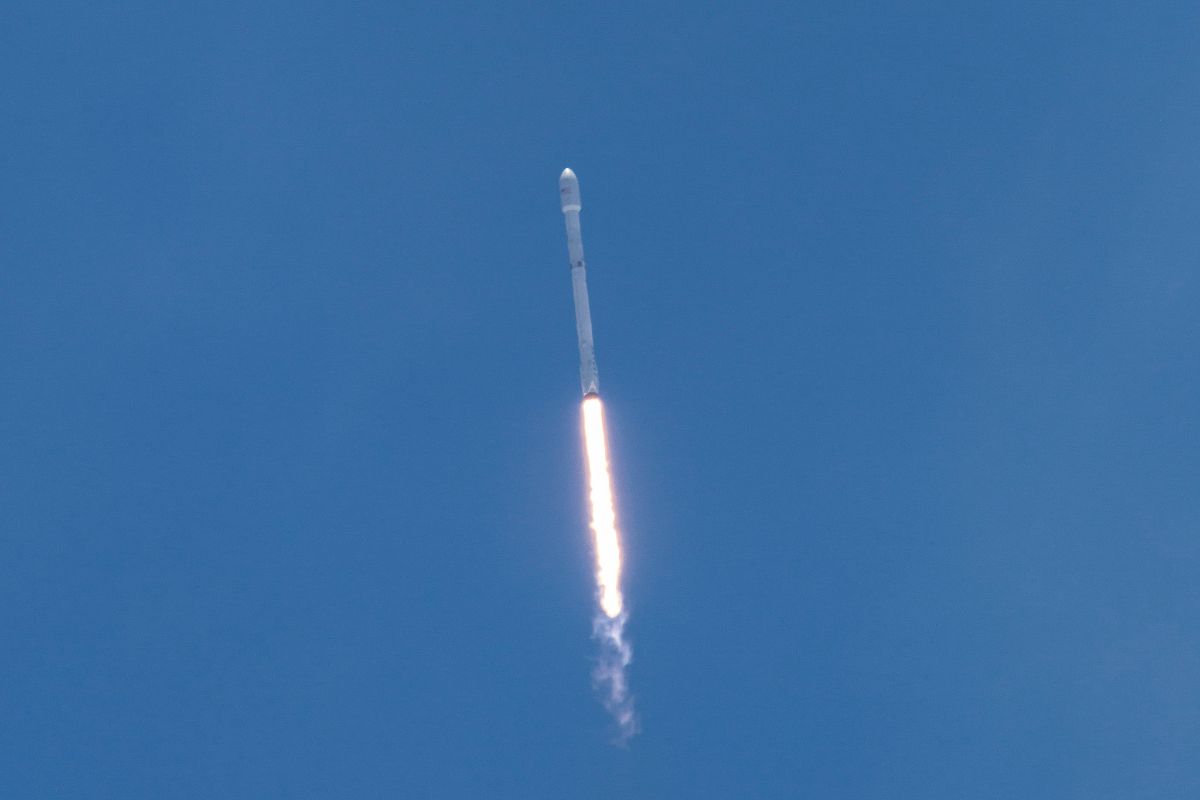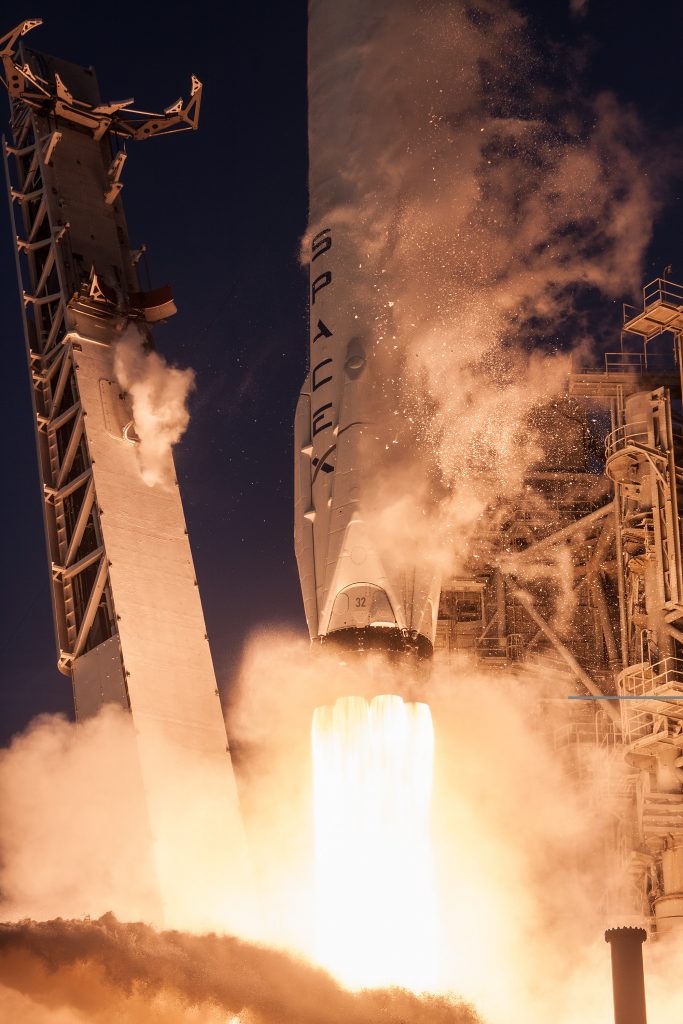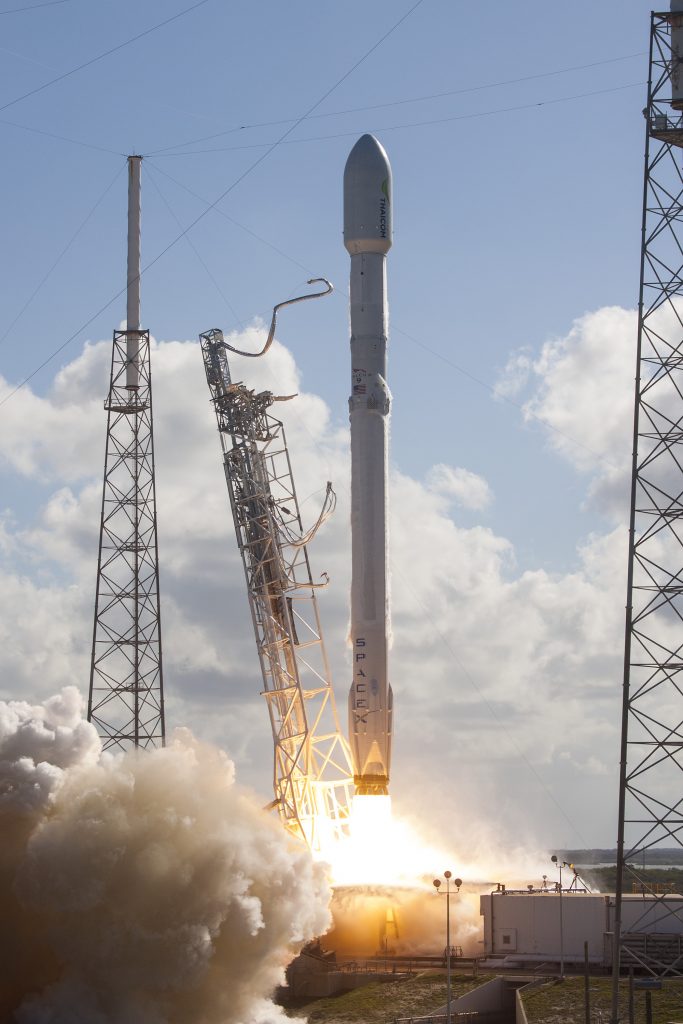
SpaceX is targeting Friday, March 30 for a Falcon 9 launch of the Iridium-5 NEXT mission from Space Launch Complex 4E (SLC-4E) at Vandenberg Air Force Base in California. This is the fifth set of 10 satellites in a series of 75 total satellites that SpaceX will launch for Iridium’s next generation global satellite constellation, Iridium® NEXT. The instantaneous launch opportunity is at 07:13:51 PDT (10:13:51 EDT; 14:13:51 UTC), and the satellites will begin deployment about an hour after launch.
A backup instantaneous launch opportunity is available on Saturday, March 31 at 7:08 a.m. PDT or 14:08 UTC. Falcon 9’s first stage for the Iridium-5 mission previously supported the Iridium-3 mission from SLC-4E in October 2017. SpaceX will not attempt to recover Falcon 9’s first stage after launch.
 |
|
Launch date:
|
March 30, 2018
Instantaneous Launch Window:
|
7:13:51 a.m. PST/14:13:51 UTC
Backup Launch Window:
|
Saturday, March 31 (7:08 a.m. PDT/14:08 UTC)
Launch site:
|
SLC-4E Vandenberg Air Force Base, California, USA
{colsp=2}
[highlight]L[eventtimer]2018-03-30 14:13:51;%c%%ddd%/%hh%:%mm%:%ss%[/eventtimer][/highlight]

Mission Patch
Launch coverage:
Payload:
The payloads for this launch are the fifth set of 10 Iridium® NEXT satellites. Iridium NEXT will replace the world's largest commercial satellite network of low-Earth orbit satellites in what will be one of the largest "tech upgrades" in history. Iridium has partnered with Thales Alenia Space for the manufacturing, assembly and testing of all 81 Iridium NEXT satellites, 75 of which will be launched by SpaceX. The process of replacing the satellites one-by-one in a constellation of this size and scale has never been completed before.
Iridium NEXT is enabling the development of new and innovative products and services including Iridium CertusSM, the Company’s next-generation communications platform. Iridium Certus will deliver faster speeds and higher throughputs for Iridium's vast partner ecosystem that provides services for aviation, maritime, Internet of Things, terrestrial and government organizations. A service of this quality and value is unprecedented in the industry, and is poised to disrupt the current market status quo. Among the new technologies hosted by Iridium NEXT is the AireonSM aircraft tracking and surveillance system. In a historic first, upon completion this system will provide air traffic control organizations and aircraft operators that purchase the service with real-time, global visibility of ADS-B equipped aircraft.

Iridium's primary launch campaign consists of eight SpaceX Falcon 9 launches deploying 75 Iridium NEXT satellites. These 75 Iridium NEXT satellites are scheduled to be deployed by mid-2018. Iridium is the only mobile voice and data satellite communications network that spans the entire globe. Iridium enables real-time connections between people, organizations and assets to and from anywhere.
Specifications
Type / Application:|
- Communication
- Traffic monitoring
Operator:|
- Iridium Communications Inc.
Contractors:|
- Thales Alenia Space (prime)
- Orbital (integration)
Equipment:|
- L-band payload
- Ka-band cross-links
- Ka-band downlinks
- ADS-B payload
- AIS payload (on 58 satellites)
Configuration:|
Dimensions:|
- 3.1 m x 2.4 m x 1.5 m (Deployed "Wingspan" 9.4 m)
Power:|
- 2 deployable solar arrays
- Batteries
Lifetime:|
- 10 years (design)
- 15 years (planned)
Mass:|
- 860 kg
Orbit:|
- 780 km × 780 km, 86.4° (initial / storage orbit: 667 km × 667 km, 86.4°)
Launch Vehicle:
Falcon 9 FT represents an evolved version of SpaceX’s Falcon 9 v1.1 rocket incorporating a number of performance enhancements to enable the launch vehicle to lift heavy satellites to Geostationary Transfer Orbit while preserving the option of re-using the first stage. Operated by Space Exploration Technologies, the rocket represents the third evolutionary stage of the Falcon 9. The Falcon 9 Full Thrust (FT) vehicle is also known as ‘Falcon 9 Upgrade,’ ‘Enhanced Falcon 9,’ ‘Full Performance Falcon 9’ and ‘Falcon v1.2.’
The Falcon 9 FT launch vehicle is based on the Falcon 9 v1.1 (F9R) which in turn built on the original Falcon 9, retrospectively known as the v1.0 version of the rocket. Falcon 9 v1.0 was inaugurated in 2010 and flew successfully five times until 2013 when it was succeeded by the v1.1 version of the launcher. Falcon 9 v1.1 is retired after 15 missions, one of which was a failure. The v1.1 version itself was subject to a stepwise evolution, notably the implementation of reusability technologies on its first stage. These systems, among other changes, are standard on the Falcon 9 FT that premieres in late 2015 and is likely the final version of Falcon 9 with the maximum possible performance.

The Falcon 9 Full Thrust launch vehicle retains the overall design of the previous Falcon 9 rockets as a two-stage-to-orbit launch vehicle. Its first stage includes all systems necessary for an operational re-use of stages while the second stage is operated as an expendable rocket stage.
Falcon 9 FT stands 70 meters tall, is 3.66 meters in diameter and has a launch mass of 549,054 Kilograms. Both stages use sub-cooled Liquid Oxygen and chilled Rocket Propellant 1 as propellants consumed by Merlin 1D engines, nine of which are installed on the first stage while the second stage hosts a single Merlin 1D engine optimized for operation in vacuum.
SpaceX lists the payload capability of the Falcon 9 FT as 22,800 Kilograms to Low Earth Orbit and 8,300kg to Geostationary Transfer Orbit – these figures are for the fully expendable configuration of the vehicle. Leaving sufficient propellant margin for the return of the first stage to the Autonomous Spaceport Drone Ship for later re-use cuts the payload mass to GTO to around 5,500 Kilograms.
To achieve an operational re-usability of Falcon 9 first stages, all Falcon 9 FT rockets are outfitted with a reaction control system, four grid fins for steering and four deployable landing legs. Dropping the second stage off on its way to orbit, the first stage goes through a series of complex propulsive maneuvers before guiding itself through the atmosphere towards a target landing site for a soft touchdown under the power of one of its Merlin engines to be re-used on a future flight.
Specifications
Height:|
- 70m
Diameter:|
- 3.66m
Launch Mass:|
- 549,054kg
Stages:|
- 2
Boosters:|
- None
Mass to LEO:|
- 22,800 kg
Mass to GTO:|
- 8,300 kg
Mass to Mars:|
- 4,020 kg
Launch Cost:|
- $62M
Weather forecast for Vandenberg AFB
Time
|
Temps
|
Humidity
|
Precipitation
|
Wind
|
Weather
7:00 a.m. (Based on hourly forecast with 1 hour interval and the closest to launch time)
|
7:00 a.m. (Based on hourly forecast with 1 hour interval and the closest to launch time)
10 °C (Feels like 10 °C)
|
86%
|
5 %
|
ESE at 6 km/h
|
Sunny
Unfortunately, I can't access Vandenberg AFB's webpage, but the launch day weather forecast should be available here.
Links:
Last edited:
